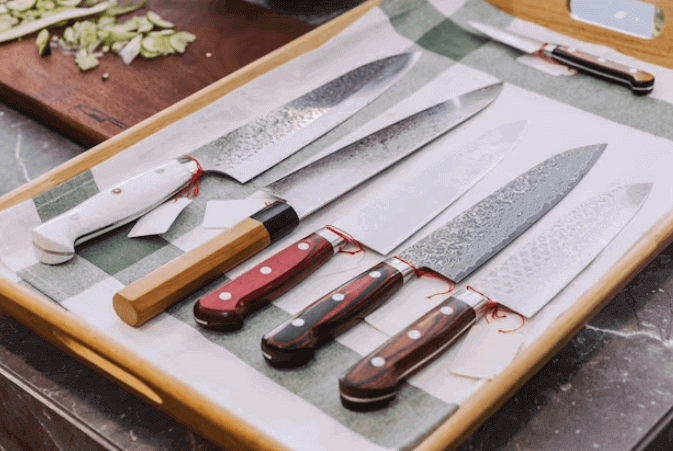
Best Japanese Knives: 21 Most Useful Ones
Introduction
These have gained immense popularity for their precision, sharpness, and unique designs. As kitchen essentials, they bring a touch of craftsmanship to every culinary experience. Let’s delve into the world of the best Japanese knives and explore the variety and excellence they offer.
History of Japanese Knives
Japanese knife boasts a rich history deeply rooted in traditional craftsmanship. Over centuries, these blades have evolved, combining age-old techniques with modern innovations, making them sought-after worldwide.
Characteristics of the Best Japanese Knives
These knives stand out for their exceptional qualities:
- High-quality steel
- Japanese knives use premium steel for durability.
- Sharpness and edge retention
- Unparalleled sharpness ensures precise cutting.
- Unique designs and patterns
- Each knife is a work of art, featuring intricate designs.
- Ergonomic handles
- Comfortable and practical for extended use.
21 Best Japanese Knives
1. Gyuto
- A top choice for chefs worldwide.
- Precision cutting with a versatile edge.
- Popular brands: Shun, Miyabi, Global.
2. Santoku
- Well-balanced and all-purpose.
- Excellent for slicing, dicing, and chopping.
- Brands to consider: Shun, Miyabi.
3. Nakiri
- Specifically designed for vegetables.
- Thin blade for precision in vegetable preparation.
- Notable brands: Shun, Miyabi, Sakai Takayuki.
4. Deba
- Ideal for filleting fish.
- Sturdy build for intricate fish cuts.
- Brands like Shun and Masamoto excel in Deba knives.
5. Usuba
- A thin, delicate vegetable knife.
- Traditional Japanese design for intricate cuts.
- Sakai Takayuki and Global offer quality Usuba knives.
6. Honesuki
- A poultry boning knife.
- Specialized for chicken and other poultry.
- Look for Honesuki knives from Miyabi and Masamoto.
7. Yanagiba
- The sushi and sashimi knife.
- Long, thin blade for precise slicing.
- Top choices: Shun, Miyabi, Masamoto.
8. Petty Knife
- Small utility knife for delicate tasks.
- Perfect for peeling and intricate work.
- Brands like Shun and Global offer excellent Petty knives.
9. Kiritsuke
- A versatile, multipurpose knife.
- Combines the functions of a Gyuto and Yanagiba.
- Brands like Shun and Miyabi produce high-quality Kiritsuke knives.
10. Bunka
- A general-purpose knife with a unique design.
- Versatile for various kitchen tasks.
- Consider brands like Shun and Miyabi for Bunka knives.
11. Sujihiki
- Long slicing knife for meats and fish.
- Thin blade for precise slicing.
- Brands like Global and Sakai Takayuki offer quality Sujihiki knives.
12. Nagiri
- Shorter, more nimble version of the Gyuto.
- Suitable for those who prefer a smaller knife.
- Explore options from Shun and Global for Nagiri knives.
13. Takobiki
- Specialized knife for octopus preparation.
- Long, flat blade for intricate cuts.
- Look for Takobiki knives from Sakai Takayuki and Masamoto.
14. Yo-Deba
- Western-style heavy-duty fish knife.
- Combines the Deba style with a Western handle.
- Brands like Shun and Miyabi offer quality Yo-Deba knives.
15. Yanagi Deba
- Fusion of Yanagiba and Deba styles.
- Versatile for both slicing and filleting.
- Notable brands: Shun, Miyabi, Masamoto.
16. Chukabocho
- Chinese-style cleaver with a Japanese twist.
- Versatile for chopping and slicing.
- Explore options from Shun and Global for Chukabocho knives.
17. Kogatana
- Small utility knife for intricate tasks.
- Ideal for detailed cutting and carving.
- Brands like Shun and Miyabi offer quality Kogatana knives.
18. Mukimono
- A vegetable knife with a narrow blade.
- Designed for precision in vegetable carving.
- Brands like Global and Sakai Takayuki excel in Mukimono knives.
19. Kurouchi
- Traditional black-finished knives.
- Rustic appearance with high performance.
- Look for Kurouchi knives from Masamoto and Sakai Takayuki.
20. Wa-Bocho
- Traditional Japanese-style knives.
- Wooden handles for a classic touch.
- Consider brands like Miyabi and Sakai Takayuki for Wa-Bocho knives.
21. Hankotsu
- Specialty knife for boning and butchering.
- Sturdy build for challenging tasks.
- Brands like Masamoto and Global offer quality Hankotsu knives.
Elevate your culinary skills with these exceptional Japanese knives, each designed for specific tasks and crafted by renowned brands known for their precision and quality.
Choosing the Right Japanese Knife for Your Needs
Selecting the perfect Japanese knife involves considering the type, budget, and maintenance requirements. Understand your culinary needs to make an informed choice.
Tips for Caring for Japanese Knives
- Proper cleaning methods
- Hand wash with mild soap and avoid abrasive materials.
- Storage recommendations
- Use blade guards or magnetic strips to protect the edges.
- Honing and sharpening techniques
- Regular honing maintains sharpness; sharpen when necessary.
Benefits of Using Japanese Knives
- Precision in cutting
- Achieve fine cuts with ease.
- Versatility in the kitchen
- Adapt to various cooking styles effortlessly.
- Aesthetic appeal
- Enhance your kitchen aesthetics with beautifully crafted knives.
Popular Japanese Knife Myths Debunked
- Japanese knives are only for professionals
- Suitable for home cooks; proficiency grows with use.
- All Japanese knives are expensive
- Affordable options are available without compromising quality.
Future Trends in Japanese Knife Making
As technology advances, anticipate a fusion of traditional craftsmanship with modern techniques. The future promises exciting developments, maintaining the essence of Japanese knife-making while embracing innovation.
Conclusion
In conclusion, the best Japanese knives offer more than just tools for the kitchen; they embody a legacy of craftsmanship, precision, and artistry. Explore the diverse world of these knives to elevate your culinary experience.
FAQs
- What makes Japanese knives different from other knives?
- Japanese knives are known for their exceptional sharpness, unique designs, and high-quality steel, setting them apart from other types.
- Are Japanese knives suitable for everyday use?
- Yes, Japanese knives are versatile and well-suited for daily kitchen tasks, making them ideal for everyday use.
- How often should I sharpen my Japanese knife?
- Sharpen your Japanese knife as needed, depending on usage. Regular honing helps maintain the sharp edge.
- Can I use Japanese knives for cutting through bones?
- Japanese knives are not designed for heavy-duty tasks like cutting through bones. Use a specialized knife for such purposes.
- Are there affordable options for Japanese knives?
- Yes, there are affordable Japanese knives available that offer excellent quality and performance. Consider your budget and requirements when making a choice.
Visit our website for more. Click here: “Quick Trend Insights“.





